Alcazaba Fortress
History, Towers, Military design, & Architecture
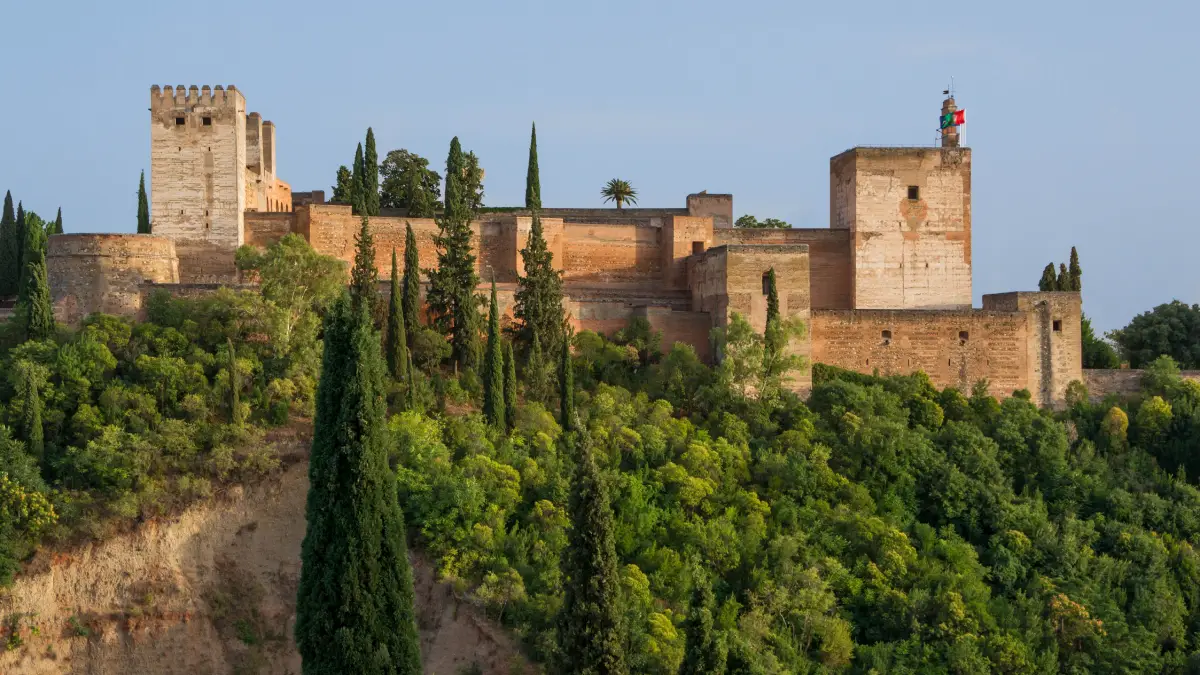
The Alcazaba is a historic fortress located within the Alhambra Castle in Granada and is one of the oldest and most iconic parts of the site.
It forms the military heart of the Alhambra, originally built in the 11th century and later expanded during the Nasrid period.
Designed purely for defense, the Alcazaba features thick walls, watchtowers, and hidden entrances that showcase its strategic importance in protecting the city.
In this article, you’ll uncover the fascinating history of the Alcazaba, walk through its key structures, and learn about its military architecture.
The Alhambra Castle attracts over 2.6 million visitors annually, so booking in advance is a smart choice. The skip-the-line ticket is the most popular and budget-friendly option. For a deeper understanding of the palace, the guided tour offers expert insights, while the night tour provides a magical experience in a peaceful atmosphere.
History of the Alcazaba
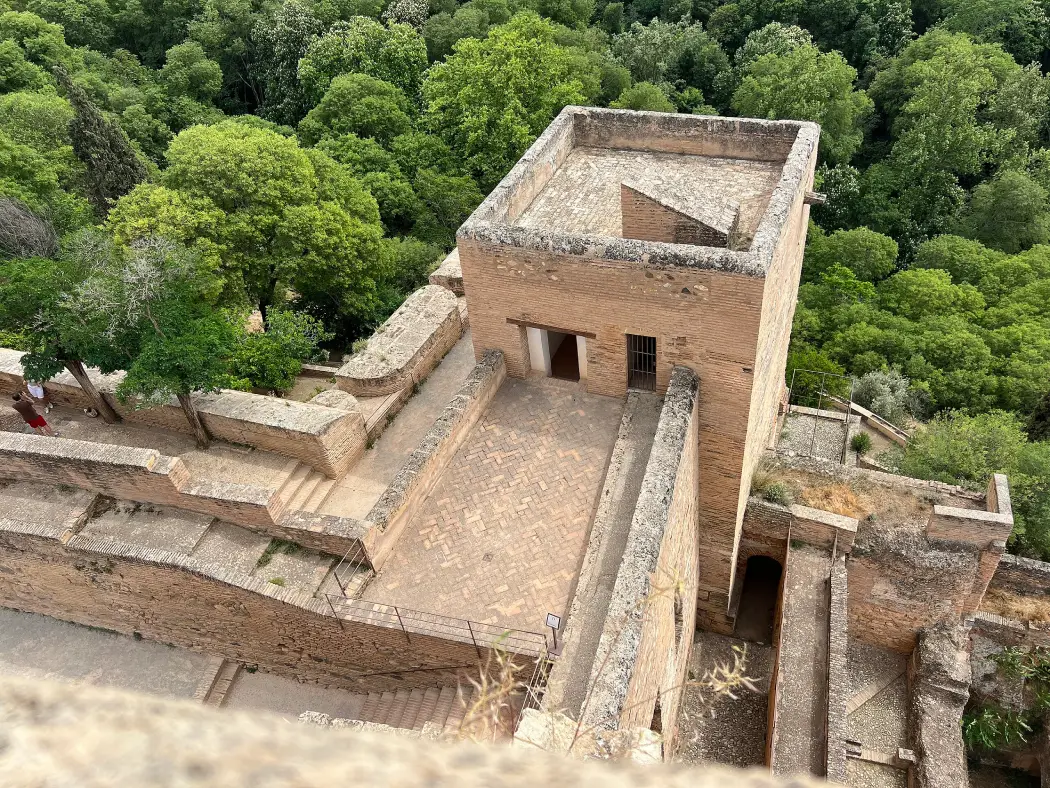
The Alcazaba was originally built as a fortress to protect Granada, with its strategic position on Sabika Hill offering clear views of the surrounding area to spot approaching enemies.
It was first strengthened in the 9th century, and later became part of the military complex known as al-Qasaba al-Jadida (the new citadel) under the Zirid dynasty in the 11th century.
In 1238, Muhammad I, founder of the Nasrid dynasty, rebuilt and expanded the fortress, adding stronger walls and the Torre del Homenaje.
In 1492, the Catholic Monarchs raised their flag on the Torre de la Vela, marking the official end of Islamic rule in Spain.
The fortress was later adapted for gunpowder warfare and underwent restoration in the 20th century, preserving its historical and architectural integrity.
Today, the Alcazaba stands as a powerful symbol of Al-Andalus, reflecting both its military strength and the blending of Islamic art with fortress design.
What you can see inside the Alcazaba
The Alcazaba isn’t just a fortress—it’s a walk through centuries of military history. As you explore its towering walls, ancient gates, and open courtyards, you’ll gain insight into how this defensive stronghold protected Granada’s rulers and shaped its history.
Plaza de los Aljibes
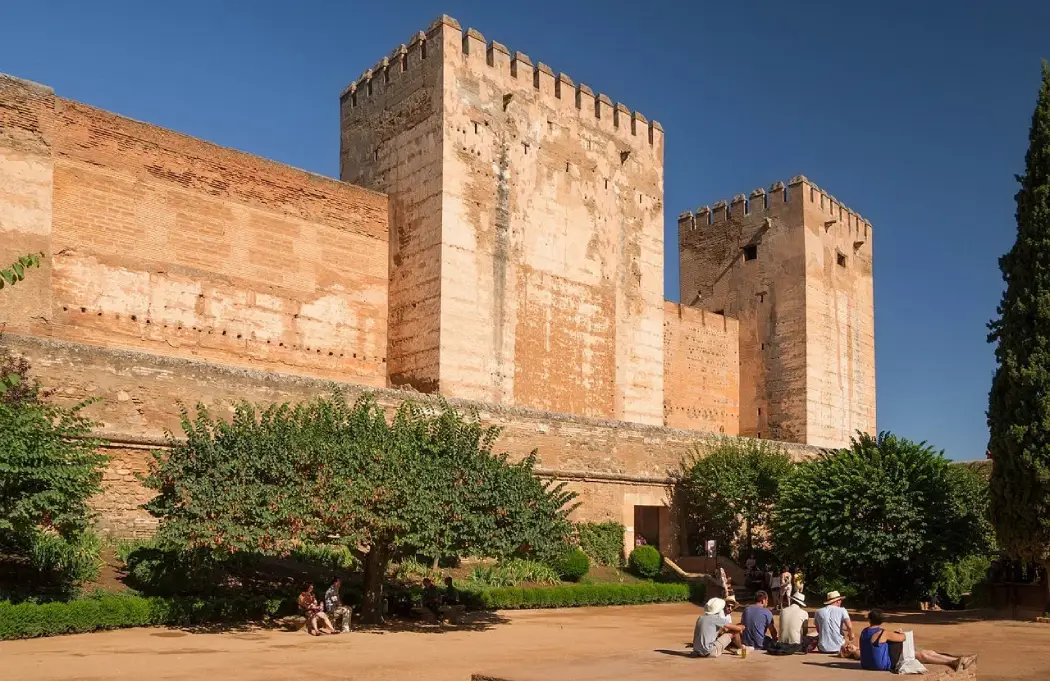
Located between the Alcazaba and the Nasrid Palaces, Plaza de los Aljibes is a large open square named after the cisterns built here in the late 15th century to store water.
While not a cultural hub in ancient times, today it’s a popular viewpoint and gathering spot for visitors and offers scenic views of the city and fortress walls.
Puerta de las Armas
This is one of the oldest entrances to the Alcazaba, built in the 14th century during the Nasrid period.
Found on the northern wall, it was once the main gateway for soldiers and supplies coming through the San Pedro forest.
Designed with defensive curves and a horseshoe arch, it reflects the fortress’s military purpose. Though no longer in use, it remains a key part of the Alhambra’s structure.
Plaza de las Armas (Arms Square)
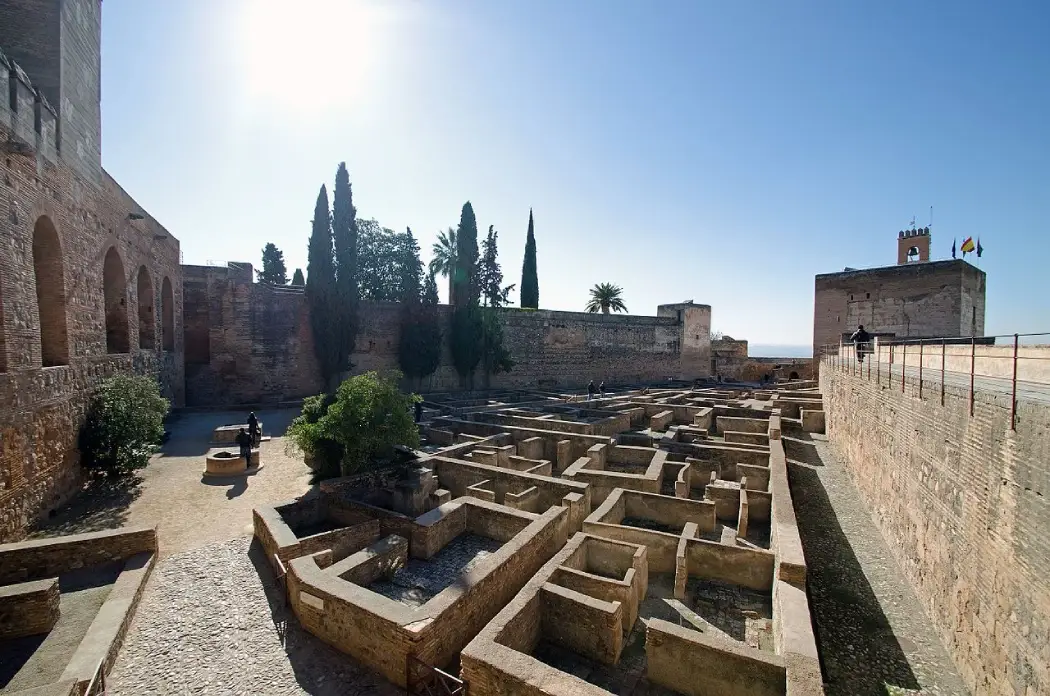
Plaza de las Armas is the main courtyard inside the Alcazaba, located next to the Puerta de las Armas.
In the past, it was a central space for military activities, including training drills, gatherings, and planning strategies for defense. It also served as the main entrance to the fortress during ancient times.
Soldiers lived and worked in this area, and even today, you can still see the ruins of their houses, storerooms, and other structures, offering a glimpse into how the fortress functioned during Moorish rule.
Torre del Homenaje
Torre del Homenaje is the tallest tower in the Alcazaba and was used as a military command post.
It had five floors, including living quarters for the commander of the guards. The tower’s terrace offered wide views of the area, making it useful for sending visual signals.
It also served as the final defense point if the fortress was attacked, making it one of the most important towers in the fortress.
Torre de la Vela
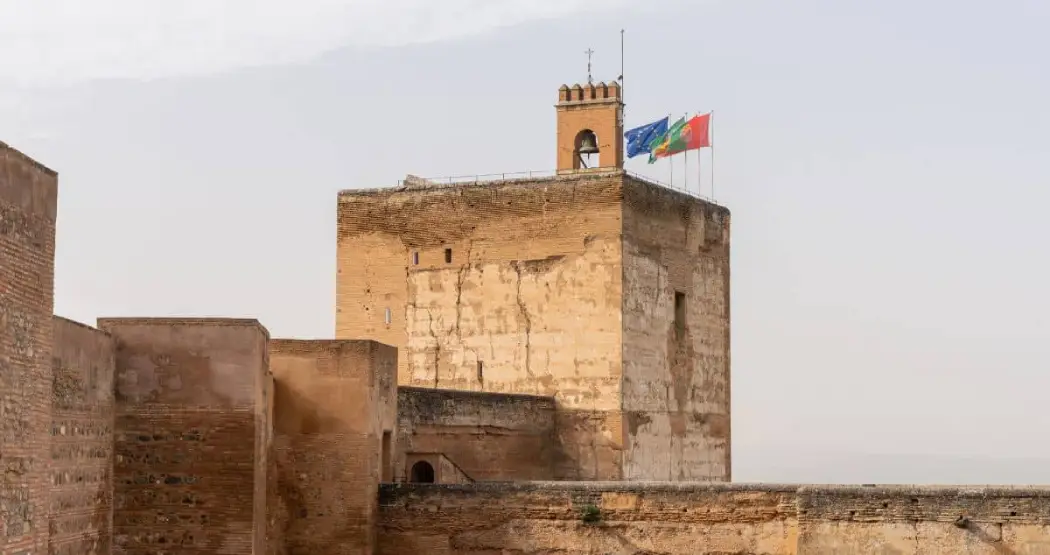
Torre de la Vela is the most iconic tower in Alcazaba, known for its large bell and panoramic views of Granada and the Vega valley.
Once home to bell ringers during the time of the Catholic Monarchs, the bell was used to signal time and guide farmers with irrigation.
Today, the tower flies four flags: Andalusian, Grenadian, European, and Spanish—and is a favorite photo spot for visitors
The bell tower has been rebuilt and repositioned several times over the years.
Torre Quebrada
Torre Quebrada, also known as Torre del Cantón, is a defensive tower on the eastern wall of the Alcazaba, built during the reign of Yusuf I over an older Zirí-period structure.
It has a U-shape, two floors with chambers, and a crenellated terrace.
In 1838, a landslide damaged the tower,leaving a visible crack that gives the tower its name “Broken Tower.” It still stands today with its two floors and crenellated terrace.
Torre de la Pólvora
Torre de la Pólvora, also known as the “Powder Tower” or “Guard Tower”, is a small defensive tower in the Alcazaba, located behind the Torre de la Vela.
Built in the 13th century, it projects from the wall, giving it a strategic view over Cuesta de Gomérez, a key access route to the Fortress.
After the Christian conquest, it was reinforced and used as an artillery platform, where gunpowder and cannons were stored and handled, giving the tower its name.
Jardín de los Adarves (Garden of the Ramparts)

The Jardín de los Adarves is located on the southern ramparts of the Alcazaba. It was originally a defensive walkway, used by soldiers to patrol and guard the fortress.
Later in the 16th century, the space was transformed into a peaceful garden. It features lush greenery and two historic fountains, one from 1624 with arabesque designs, and another from 1628 with carvings of genies riding dolphins.
Today, it offers a relaxing spot with beautiful views and a blend of Moorish and Renaissance styles.
Military design and architecture of Alcazaba
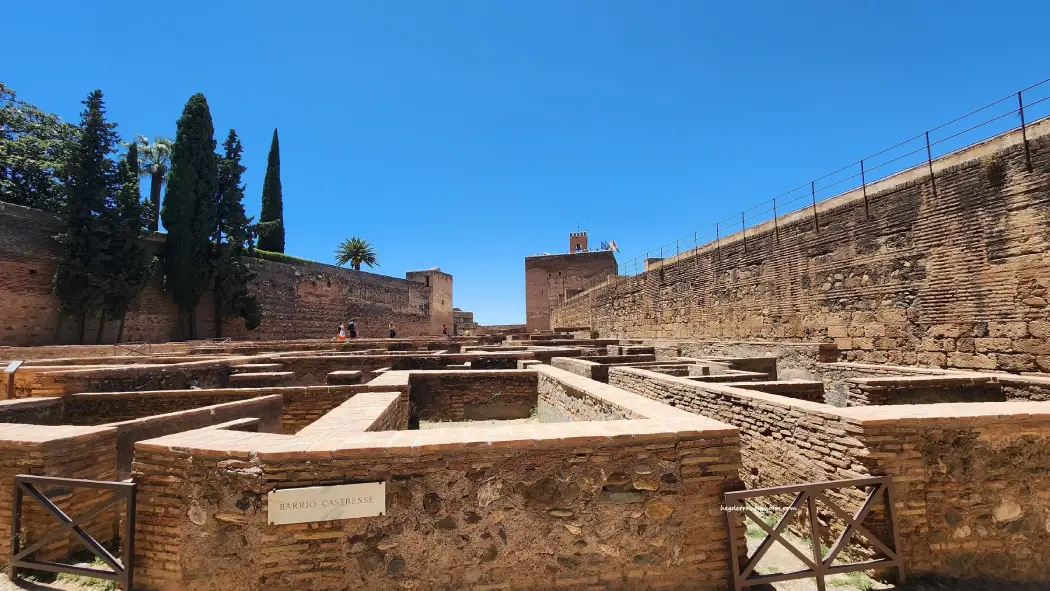
The Alcazaba is the oldest and most defensive part of the Alhambra, built for protection rather than decoration.
Its purpose was to protect the royal city, making it the military heart of the complex.
Located on the western tip of the Alhambra, it follows a triangular layout and overlooks the Granada Valley, offering clear views to detect any approaching threats.
The fortress features:
- Thick rammed-earth walls for durability
- Narrow inner paths to control movement and improve defense
- Tall watchtowers, like Torre de la Vela and Torre del Homenaje, positioned for surveillance and protection
- Multiple layers of walls that separated the fortress from the rest of the Alhambra and the city
Built on the base of a 9th-century structure, the Alcazaba also included hidden entrances and strong bastions.
Inside, visitors can still see the ruins of a military residential zone, including houses, storage rooms, dungeons, and even baths, reflecting the daily life of its garrison.
After its military role declined in the 16th century, spaces like the Jardín de los Adarves were added to introduce greenery and soften the fortress’s defensive design.
Transformation of the Fortress after the 16th Century
After the Catholic Monarchs took Granada in 1492, the Alcazaba’s military importance began to decline and became a symbol of transition from Islamic to Christian rule.
In the 16th century, it was modified to handle gunpowder artillery, but soon became outdated and saw little use.
Parts of the fortress, like the Jardín de los Adarves, were transformed into peaceful gardens.
In the 20th century, restoration efforts helped preserve the Alcazaba as a cultural and historical landmark rather than a defensive structure.
